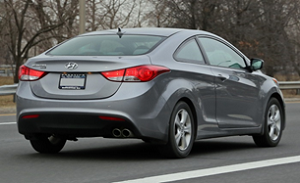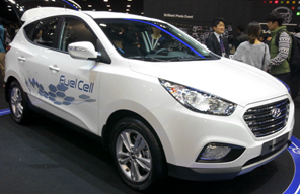InTrans / May 28, 2015
Going Green: ‘Green’ alternatives to the ‘gas guzzler’
Go! Magazine
 posted on May 28, 2015
posted on May 28, 2015
In the last article, “Going green: The history of re’new’able energy,” we explored the history and incentives behind using renewable energy. The United States really began to rethink energy policy following the energy crises of the 1970s, which resulted in several new energy-efficient laws. In this article, we will explore some “green technologies” and what the next steps are for “green” electricity.
Did you know that most of the renewable energy we use—such as hydropower, solar, geothermal, biomass, and wind—are, in most cases, actually converted to electricity? Because most vehicles run on fuel, this means renewable energy does not compete with oil in the transportation industry. Today, about 97 percent of all energy used for transportation comes from the burning of fossil fuels. This is alarmingly high, especially considering the fact that fossil fuels release harmful greenhouse gases that contribute to climate change.
Something’s got to change!
There are two things in recent decades that have helped shift the United States toward “greener” automobiles in the transportation sector: legislation and high gas prices. In terms of legislation, efforts have been made to make more fuel-efficient vehicles, mandating that all automobiles get at least 54.5 miles per gallon (mpg) by 2025 (currently only 29 mpg). There has also been legislation to implement renewable fuel standards for the use of biofuels. In 2005, the United States Congress passed an energy policy act called the Renewable Fuel Standard (RFS), which mandated that biofuels be mixed with gasoline and diesel (creating a mixture of 10 percent biofuels and 90 percent gasoline/diesel).
Additionally, fuel cell vehicles (FCVs) or fuel cell electric vehicles (FCEVs) have been gaining in popularity as alternatives to the gas guzzlers of the past, especially since gas prices have greatly increased over the last several decades.
Alternatives to gasoline vehicles
The first American electric car was developed in 1890 by William Morrison of Des Moines, Iowa. The car was only capable of traveling about 14 miles per hour (mph). Following the energy crises of the 1970s, and later in the 2000s, Americans have become more and more interested in electric vehicles.
Electric vehicle sales have shown to correlate with the prices of gas, which, as of 2014, has dipped to its lowest since the recession in 2009. As prices remain low in 2015, it is difficult for consumers to feel motivated to spend more for an electric vehicle. In comparing the Nissan Leaf (that gets 101 mpg on the highway) and a Hyundai Elantra (33 mpg), the sticker price of the Nissan Leaf is 68 percent higher at $29,000 versus $17,250 for the Hyundai Elantra. However, this does not include the $7,500 rebate given by the U.S. Federal Government (making it closer to 25 percent higher) for purchasing a fuel efficient car, nor does that sticker price reflect the cost of energy required to power the Nissan Leaf versus the internal combustion engine of the Hyundai Elantra. Let’s take a closer look. If each car drove 100 miles on the highway, the Nissan Leaf (cost of electricity being $4.08) ended up costing about half as much as the Hyundai Elantra (cost of fuel being $9.58) to travel the same distance. So, if both cars were driven for 100,000 miles, for example, the Hyundai Elantra would cost about $9580 (with a total of $26,830) and the Nissan Leaf would only cost $4080 (total of $25,580), making the electric-powered Nissan Leaf more cost efficient over time.

Fuel cell vehicles are much more “new-age” than electric vehicles. The first fuel cell vehicle was created by General Motors (GM) in 1966, who only created one vehicle—called the “Chevrolet Electrovan”—due to the high cost of production. The first mass-produced fuel cell vehicle was the Hyundai Tuscon in 2014. However, the Hyundai Tuscon is only available for lease in the United States, which costs, for a three-year lease period, about $21,000. The Hyundai Tuscon uses hydrogen as its fuel source, which is stored in the fuel cell and can create energy when combined with oxygen. Fuel cell vehicles can “fill-up” using hydrogen fuel in the same manner as other cars that use gasoline, which makes the refueling process drastically shorter than that of electric vehicles—only 10 minutes versus three hours! Did you know that the Hyundai Tuscon can travel 265 miles on one tank of hydrogen? Fuel cell vehicles like the Hyundai Tuscon have similar fuel efficiency as gasoline-powered vehicles, but instead of emitting carbon dioxide and other greenhouse gases emit only water.

The truth about “green”? cars and what’s next?
An electric car or fuel cell car seems pretty “green,” right? You would think so, but this is not exactly right. Although direct emissions are much less than that of a gasoline-powered vehicle, the emissions from producing the electricity or from sourcing hydrogen (which can come from natural gas) to power the car must also be considered. The thing to remember about these “green” cars is that electricity is their fuel source, and over 60 percent of electricity comes from coal and natural gas.
So, what have we learned so far? We’ve learned that fuel cell and electric vehicles could greatly reduce harmful car emissions, which currently contribute to one-fifth of all United States emissions. But in order to change this, we must invest in green energy to power electric and fuel cell vehicles! In the next article, “Going green: Who is powering our ‘green’ future?,” we’ll explore who is investing in green technology to make cleaner electricity and hydrogen.
Related links
https://www.hyundaiusa.com/tucsonfuelcell/
http://www.greentechmedia.com/articles/read/how-to-invest-in-renewables
By Jackie Nester, Go! Staff Writer